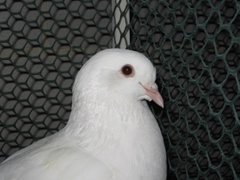
Bird 57
Gender: Female
Birth date: Unknown (from older group)
Preferred Partner: Unknown (gets along well with Birds 58 and 64)
I know hardly anything about bird 57, so I'd like to take this opportunity to tell you about something I just learned recently as I watched the new hatchlings grow. Maybe you already know, but a few of you may be in my boat. I know the pigeons can hear. So I know they have ears. But I didn't know where they were. I think I sort of assumed they were somewhere behind their eyes like ours are. Not so. If you look at Bird 57, you will see a dark spot just below her eye. It is dark because there are very few feathers there, and there are very few feathers there because that is her ear! (see Bird 45 - the third picture down for the best shot of bare baby ears)
Other interesting things I have learned about their bodies...
They, unlike many other birds, drink their water by using their beak like a straw and sucking up the water.
Blood runs into the shaft of each feather up to a certain point. If the shaft breaks, the pigeon will pull out the entire feather. If it doesn't pull the feather, the blood will not clot and the bird will bleed to death. (If this ever happens to your bird, you can pull out the damaged feather by pulling it sharply from the base. There may be a lot of blood involved, so wear surgical gloves to protect both you and the bird - located in the drawer beside the sink. If you are unsure and your bird seems to be handling it fine, let it take care of the problem.)
How they digest food. Dr. Hesse mentioned this in our class (so sorry if it is redundant) - Pigeons have a body part called a crop that is in their throat. When the bird eats, food collects in it. Then the bird contracts the crop to grind the food (see more about eating in Bird 51's entry) before it passes on for more digestion.
Every bird has a cere (Bird 57's is very small but take a peek at Birds 37, 49 and 50) which is a small piece of skin at the base of their beaks that opens/closes and protects their air passages. The word cere is derived from the Latin word for wax because the skin is somewhat waxy.
Our birds are not true albinos, but they are close. To be true albinos, they would have pink eyes. Our birds have normal eyes and can see as well as wild non-albino pigeons. Recently it has also become clear that a few color genes have come into our lab and our newer birds have some brown mixed into their white.

No comments:
Post a Comment